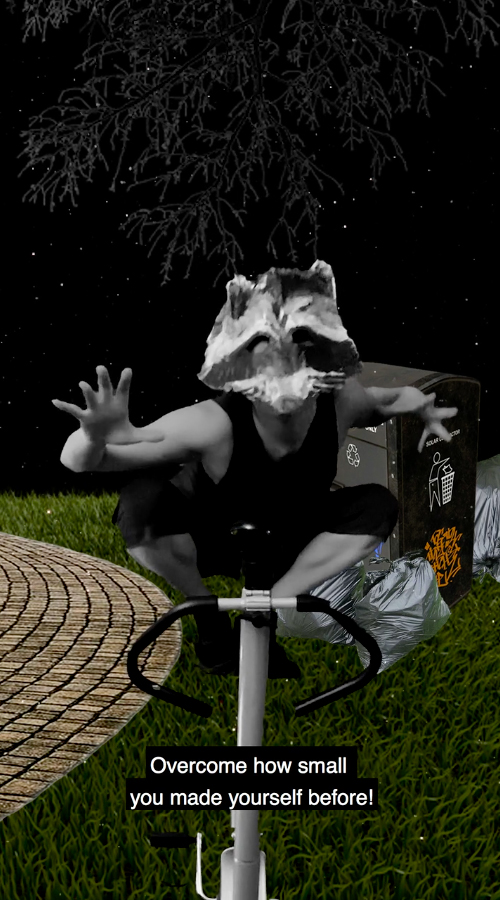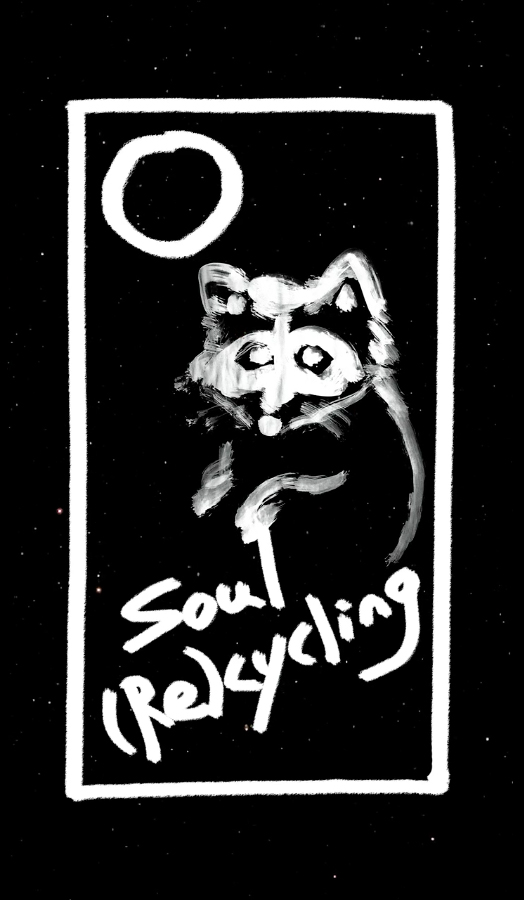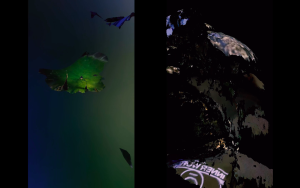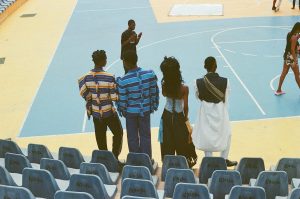
THE AMERICAN DREAM: INDENTURED SERVITUDE SUBLATED
Word Count: 1,354 |
Download this article
by •
SALVAGE
with SOUL (RE)CYCLING WITH RACCOONS IN HUMAN-TIME
a video by LAURA HYUNJHEE KIM
Classically, dream interpretation involves deciphering an individual’s impulses or conflicts hidden behind symbolic images or narratives. Collective dreams can be similarly approached.
What normally comes to mind with the phrase “The American Dream”? Perhaps it’s a gauzy image of Old Glory undulating in slow motion against a blue sky. For many, it would immediately conjure the prospect of home ownership, whether that’s a small town house with a white picket fence, a suburban McMansion on a cul-de-sac, or a stylish urban loft—and of course a vehicle of one kind or another, whether a tricked-out pickup truck or an eco-signaling Tesla. In the few urban enclaves where vehicles are unnecessary, a car can be a luxury add on, a stylistic expression of excess wealth.
But the reality is that only a small minority of working Americans actually own their homes, or their automobiles, for that matter. The ultimate legal owners of most homes and vehicles are the financial institutions that issue the mortgages for their purchase. These mortgaged “purchases” are purchases in name only, not in reality. They are contracts for payment—eventually double or triple the asking price—spread over years, committing the “buyer” to work for years for a place to live and the means to work. Few people buy a home and stay there for the duration of the mortgage. Instead, there is a series of swapped contracts spread out over a lifetime of work. Around 40% of Americans over sixty-five are still paying on a mortgage.
Indentured servitude has a long history in the United States. Its first use in the Virginia colonies was virtually simultaneous with the arrival of the first slave ship in Jamestown in 1619. Indentured servitude, in contrast to slavery, was a means to obtain European laborers. While not slavery, the contracts were severe. No wages were paid; the agreement was work for food and shelter. Often they were young people misled to agree or signed over by their families. Conditions varied widely, but physical abuse was not uncommon. Escaped servants could legally be captured and returned, imprisoned, and at times executed without consequence. By the time of the Declaration of Independence, about half of the European immigrants to the United States had arrived through indentured servitude, with typical terms of indenture of about five years. Although it took until 1917 for this cousin to slavery to be finally outlawed, its frequency declined through the 18th century as the more economically profitable option, slavery, increased. By the middle of the 19th century, it had become far less common.
At the same time, mortgage lending increased significantly during the 19th century to help capitalize expanded farming. This, along with luring settlers with free land through homesteading, fueled the engine of colonization across the middle lands of America. These instruments provided the economic mechanics that accelerated the great land grab from, and cultural genocide of, indigenous peoples. One can think of this story of mid-19th century land workers as a process that was sublating overt indentured servitude, and then slavery, in the service of the larger, evolving biopolitical structure. The expansion of mortgage banking in concert with the Civil War and the abolition of overt slavery is further suggestive of a large scale sublation of worker exploitation.
This part of the American story is quite at odds with images of the free Puritan settlers at Plymouth Rock. From their narrative, and the idealized narratives of westward expansion, arises the fantasy of the bootstrapped American who, by sheer effort and determination, builds a life for themselves and their family out of the raw materials of a bountiful nature. Of course, the reality for many settlers—mislead by promises of fruitful lands, such as those stranded in the barren reaches of the Dakotas—was miserable and desperate.
There is another American story, a story of exploitation creating vast wealth for the few. There are many other permutations of this story, for example squalid housing compounds near factories where workers could barely eke out a life with their meager wages, or the desperate conditions around coal mines that trapped families in hardship for generations.
When home mortgages began to be issued in the early-20th century they were proctored mostly by insurance companies (not banks), tended to be usury, and very often ended with confiscation of property. Collapsing piles of faded boards still haunt the prairies from this time. Wildly unregulated, a massive real estate bubble with a resulting wave of foreclosures was one of the triggers to the Great Depression. Roosevelt’s Home Owners’ Loan Act of 1933 stopped the hemorrhage in the mortgage system and introduced government regulation and oversight. Such New Deal policies, along with the emergence of legally protected workers’ rights, muted the blatant exploitation of workers, including slaves, that characterized the first three centuries of the American story.
Perhaps it’s not such a puzzle how the wealthiest nation on the planet remains so retrograde in providing basic healthcare, basic childcare, and equitably distributed education compared with other developed nations. Behind the wish-fulfilling American dream of freedom and independence, manifested in the symbol of one’s own home, is a thinly veiled psychohistorical reality of entrapment and exploitation. A reality we have yet to transcend despite the means to do so.
SOUL (RE)CYCLING WITH RACCOONS IN HUMAN-TIME
Soul (Re)cycling with Raccoons in Human-Time was created while in self-isolation during the pandemic. The piece was inspired from taking short nightly walks around the block and sharing moments of pause, locking eyes with numerous nocturnal scavengers in the neighborhood dumpster. The work positions a (non)human raccoon as a speculative fitness instructor and playfully remixes zoological studies with language from the tele-fitness industry, specifically that of indoor cycling classes and live stream workout products. By embodying the persona of a raccoon, speaking to and from them on “how to survive human-time,” the (non)human performance becomes a complex site for tending to an improbable future, troubling the fragility of timescales—asking which time are “we” ready to survive in and whose survival are “we” preparing for? In short, the project intends to explore the indeterminacy of cohabitation-in-the-making for survival: the absurd processes of anthropomorphism that helps humans reimagine kinship with nonhumans and the necessity to share resources and maintain a balanced relationship with all (non)living beings in the biosphere for coexistence.
– Laura Hyunjhee Kim

DR STEPHEN SETTERBERG publisher
Dr. Stephen Setterberg is Publisher of Stillpoint Magazine. He is a psychiatrist and psychoanalytic psychotherapist who founded and developed the PrairieCare system of clinics and hospitals for children and adolescents in Minneapolis, Minnesota, USA. While later training in Zurich to become a Jungian analyst, Stephen co-founded Stillpoint Spaces, a forum for psychologically-minded individuals of diverse cultural and educational backgrounds to utilize insights from psychoanalysis, psychotherapy, and related fields, with centers in Berlin, London, Paris, and Zurich. He also co-directs Confer, a UK organization first established by psychotherapists in 1998 to provide interdisciplinary continuing education for psychotherapists, psychologists, and other mental health workers.
LAURA HYUNJHEE KIM artist
Laura Hyunjhee Kim is a multimedia artist who reimagines on/offline (non)human interactions and feelosophical experiences of the body. Thinking through making, she performs moments of incomprehension. In 2020, Kim received the Judson-Morrissey Excellence in New Media Award and the Black Cube Video Art Award. She is the author of Entering the Blobosphere: A Musing on Blobs (The Accomplices) and coauthor of Remixing Persona (Open Humanities Press). Kim is an assistant professor of visual and performing arts at The University of Texas at Dallas and lives in the company of neighboring squirrels, birds, and wild rabbits.
SOUL (RE)CYCLING WITH RACCOONS IN HUMAN-TIME: Video (3:43min). Soundtrack by Chris Corrente.
© Copyright for all texts published in Stillpoint Magazine are held by the authors thereof, and for all visual artworks by the visual artists thereof, effective from the year of publication. Stillpoint Magazine holds copyright to all additional images, branding, design and supplementary texts across stillpointmag.org as well as in additional social media profiles, digital platforms and print materials. All rights reserved.


